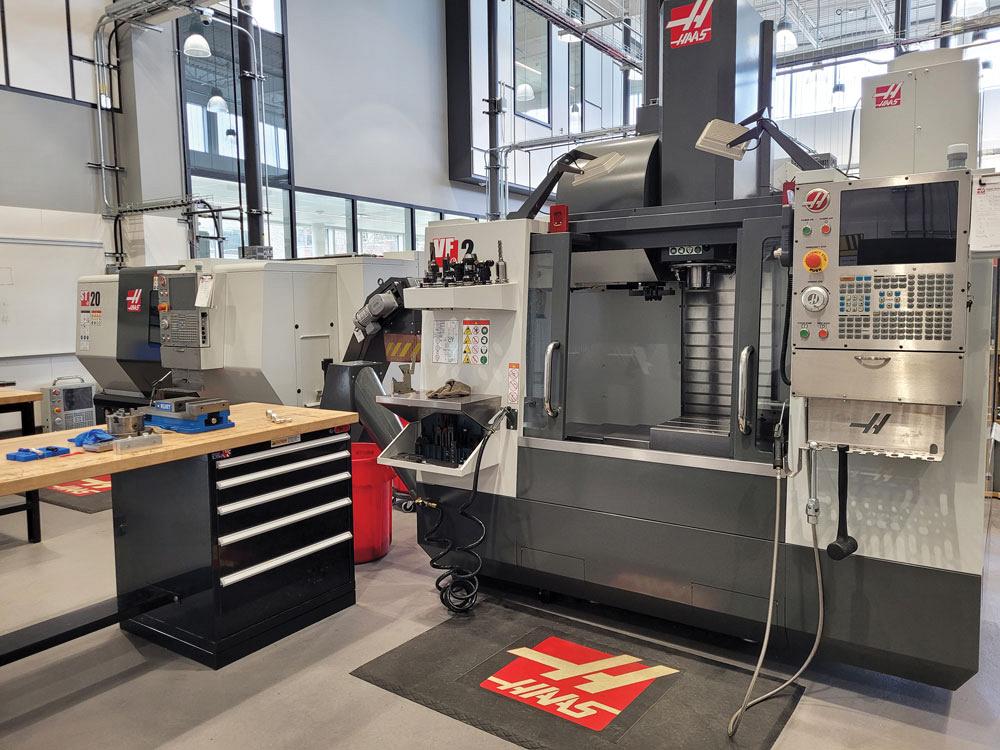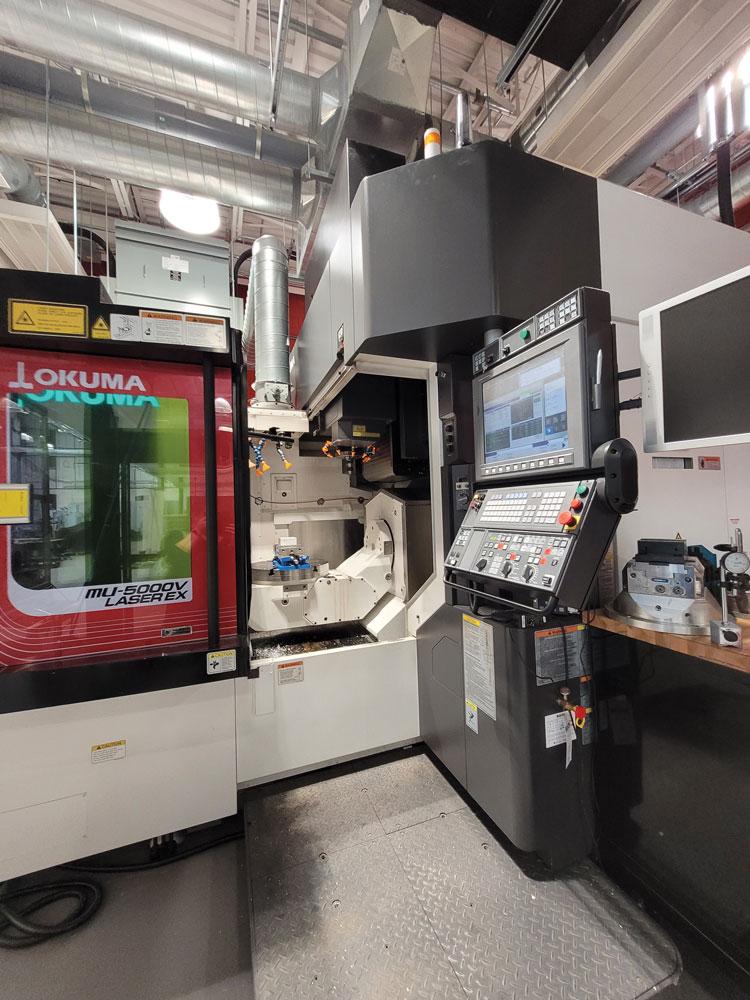Associate Editor
- FMA
- The Fabricator
- FABTECH
- Canadian Metalworking
Technology centre fills the innovation gaps for local manufacturers
Red River College’s TACAM applied research team helps companies become more competitive
- By Lindsay Luminoso
- July 3, 2023
- Article
- Metalworking
WHO:
Technology Access Centre for Aerospace & Manufacturing
WHAT:
A research centre to support the aerospace and manufacturing sectors by providing access to the college’s technological assets, specialized facilities and equipment, subject-matter expertise, and funding opportunities.
WHERE:
Red River College Polytechnic—Notre Dame Campus, 2055 Notre Dame Ave., Winnipeg, Man. R3H 0J9.
WHEN:
The centre officially launched in 2012.
WHY:
Local industry benefits through applied research, support for product development, technology evaluation and demonstration, technical support, knowledge and technology transfer, and specialized training.
TECHNOLOGIES OFFERED:
- Smart Factory: Evaluate emerging technologies such as advanced robotics, factory automation and simulation, additive manufacturing, reverse engineering, and industrial network technologies.
- Model Factory Machine Shop: Manufacturing experts provide design, prototyping, inspection, machining, additive manufacturing, and other services.
- Centre for Aerospace Technology & Training: Evaluate new joining and bonding processes and materials before making a major capital investment.
- Centre for Non-destructive Inspection: Inspect new and existing composite products using the Laser UT System.
- Composites Model Factory: Manufacture and assemble composite aerospace components and get the training needed.
- Mobile Services and Remote Work: Experts work directly at a client facility to provide technical support, problem solving, or staff training.
HOW:
Manufacturers can reach out to TACAM at www.rrc.ca/tacam.
Skilled Trades and Technology Centre (STTC)
In 2018, Red River College Polytechnic opened the STTC, a state-of-the-art $60 million facility to help boost skilled trades training at the college’s Notre Dame Campus.
With over 100,000 sq. ft. of space, the STTC comprises a new laboratory, shop space, and classrooms for students in high-demand trades and technologies.
The STTC also supports technology and innovation in other related industrial sectors such as robotics and automation, hydraulics and pneumatics, materials, electronics, CAD, and houses the Innovation Lab for applied research initiatives and industry and student projects.
Technology Access Centre for Aerospace and Manufacturing (TACAM)
TACAM, led by Dele Ola, PhD, operates the Smart Factory, which is located at STTC and is now integrated with the Innovation Lab.

The Smart Factory includes the Gene Haas Innovation Lab, which houses three machining centres – a lathe, a 3-axis with a trunnion table, and a 5-axis machining centre.
“TACAM is primarily funded by the federal government through the Natural Sciences and Engineering Research Council,” said Ola. “We get funding from NSERC to support a mandate of regional innovation. Technology Access Centres are set up as research business units embedded within the Canadian colleges and polytechnic systems to interface with industry to help them to solve problems and support the journey of becoming more competitive. Smaller companies don’t necessarily have the resources or bandwidth to have a dedicated engineering department or R&D to help them innovate. We fill that gap.”
The centre is able to support industry through new product prototyping, technology test driving, technology evaluation, process and production evaluation and simulation, and training initiatives. And with 15 multidisciplinary professionals, the centre is able to solve challenges and expand the capabilities of local industry through various areas of innovation. For example, it has expertise in advanced materials and manufacturing processes, including advanced welding technologies or metal additive manufacturing.
The Smart Factory showcases the factory of the future and the benefits of shop floor interconnectivity. The TACAM team built an industrial network that includes a server room. This network is separate from the college and private, with the data maintained by the team. The network enables interconnectivity between all shop floor technologies and allows the team to explore the Industrial Internet of Things (IIoT). This Smart Factory includes robotics and automation, including collaborative robotics. It also has autonomous ground vehicles (AGVs) integrated with robotics and capabilities for programming and simulation.
“The goal of our Smart Factory is to help companies explore new and emerging technologies with the focus on adoption,” said Ola. “We can help companies reduce the risk of robotic implementation before they invest substantial amounts of money. We can evaluate and simulate different robotic solutions with different machine tools or whatever they are being used for to visualize the entire process.”
Beyond robotics and simulation, many companies come to TACAM for digital non-destructive inspection and rapid prototyping. The team has expertise in 3D reconstruction of data, using X-rays for inspection, and laser metrology for reverse engineering. It also supports mechanical design work through finite element analysis and computational fluid dynamics. It’s all about start-to-finish support for any project.
TACAM Clients
“Most of our clients are from aerospace and then manufacturing,” said Ola. “Our concept is that if a company makes anything, we can work with them. We are focused on aerospace and manufacturing, but we’ve worked with clients making medical devices, agricultural technology, mining equipment, to renewable energy projects. We are a not-for-profit research centre but we generate revenues to cover our costs.”
One of the main advantages of working with TACAM is that it can help industry by reducing the cost of innovation through government support and grants, like from the NSERC and the National Research Council of Canada Industrial Research Assistance Program (NRC IRAP). For example, if a three-month project is expected to cost $50,000, it can ask the client to provide $10,000 while it looks for $40,000 of support from other sources. Another example is Research Manitoba supporting projects through the Innovation Proof-of-Concept grant. Sometimes, however, clients require tight turnarounds and will pay for the project in its entirety.
It’s important to note that TACAM is not a production facility. It can refer clients to local machine shops and other service providers with the ability to handle that type of production. But if a company, for example, needs to go through design iterations for a part to be produced by CNC, TACAM can help in both the design iteration and small-batch production for testing purposes. The team can provide proof-of-concept products for field testing.
“Another advantage of working with us is that we have a very great industry-supportive IP policy; we normally grant 100 per cent royalty-free commercial rights to our clients,” said Ola. “No two projects are ever the same. We have people that have knowledge, industry experience, such that even if the learning curve is steep for our clients, we try to learn through the process."
Supporting Students
TACAM supports students' Work-Integrated Learning (WIL) experience by hiring and supervising a cohort of research students each semester. Students can use the expertise and technology to meet program requirements in a co-op or part-time capacity or even full-time throughout the summer.

TACAM also is the certification centre for IRC5, an operator-level, five-day intensive training for ABB.
Students are embedded in the centre’s program and projects so that they can be mentored, learn, and contribute to the cutting-edge research that is being done at the facilities.
“They get to participate in multidisciplinary projects,” said Ola. “When they graduate, they are mostly preferred by industry and often field multiple job offers. And while we are fully integrated with the academic area, we operate separately as part of the institution’s research enterprise – Research Partnerships and Innovation (RPI). Through TACAM, instructors have the opportunity to implement updates to curriculum based on the latest technology and trends demonstrated by the centre and industry.”
TACAM is also the certification centre for IRC5, an operator-level, five-day intensive training for ABB. Anyone, whether students or industry professionals, registered with ABB will be trained by instructors at the college.
Machine Shop
The Smart Factory includes the Gene Haas Innovation Lab, which is fully integrated with other technology in the facility. Currently, the lab includes three machining centres – a lathe, a 3-axis with a trunnion table, and a 5-axis machining centre.
However, the campus also includes a large machine shop dedicated to training CNC operators and machinists. It includes CNC milling machines and lathes, manual mills and lathes, surface and cylindrical grinders, a gas high-heat furnace, coordinate measuring machines, and CNC training simulators.
And because rapid prototyping is an area of expertise for TACAM, it has invested in additive manufacturing technologies with a number of fused deposition modelling (FDM) and stereolithography (SLA) 3D printers. These machines are primarily dedicated to building parts using polymers. Beyond that, the centre recently invested in an Okuma Laser Ex series MU 5000V hybrid additive manufacturing system and a Laser Powder Bed Fusion (LPBF) system by GE-Concept Laser to produce metal components. Complementary to the additive manufacturing technologies is the X-ray Computed Tomography (CT) digital non-destructive inspection system. All of these are located at the Smart Factory.
While the centre has focused on using SolidWorks as its CAD program and GibbsCAM as its CAM software, it needed to find an alternative CAM option that could support the additive process of the new hybrid additive machine.
This is where Open Mind Technologies came in. The CAM developer worked with Okuma to find a way to support its additive processes in a way that off-the-shelf options could not. Today, TACAM uses a hyperMILL package that as been developed with the hybrid additive process in mind.
About the Author

Lindsay Luminoso
1154 Warden Avenue
Toronto, M1R 0A1 Canada
Lindsay Luminoso, associate editor, contributes to both Canadian Metalworking and Canadian Fabricating & Welding. She worked as an associate editor/web editor, at Canadian Metalworking from 2014-2016 and was most recently an associate editor at Design Engineering.
Luminoso has a bachelor of arts from Carleton University, a bachelor of education from Ottawa University, and a graduate certificate in book, magazine, and digital publishing from Centennial College.
subscribe now


Keep up to date with the latest news, events, and technology for all things metal from our pair of monthly magazines written specifically for Canadian manufacturers!
Start Your Free Subscription- Trending Articles
Sustainability Analyzer Tool helps users measure and reduce carbon footprint

GF Machining Solutions names managing director and head of market region North and Central Americas

Mitutoyo updates its end-user portal

Enhance surface finish with high-speed machining

CME's Health & Safety Symposium for Manufacturers

- Industry Events
Automate 2024
- May 6 - 9, 2024
- Chicago, IL
ANCA Open House
- May 7 - 8, 2024
- Wixom, MI
17th annual Joint Open House
- May 8 - 9, 2024
- Oakville and Mississauga, ON Canada
MME Saskatoon
- May 28, 2024
- Saskatoon, SK Canada
CME's Health & Safety Symposium for Manufacturers
- May 29, 2024
- Mississauga, ON Canada

















